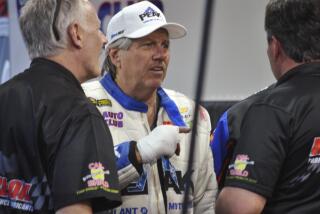Making a safe call
In the time it takes to read this sentence, a car in big-league professional drag racing can reach a top speed of 330 mph as it traverses one quarter of a mile, or 1,320 feet, in less than five seconds.
That’s five times faster than one drives on the freeway.
Now, in the aftermath of a crash that killed one of its competitors, drag racing believes that’s too fast. And the sport’s drivers are now willing to accept less speed for more safety.
“We have to slow the cars down and quit hurting and killing people. End of story,” drag racer Jerry Toliver said of the sport, which was nurtured in Southern California and now appeals to millions of fans nationwide.
It’s a historic change for a sport built on finding added speed to win, one that’s also sparked unprecedented changes by drag racing’s 57-year-old sanctioning body, the National Hot Rod Assn. in Glendora, to slow the cars down.
“We need to ratchet the speeds back some,” said Graham Light, the NHRA’s senior vice president of racing operations. “For the fans we still want 300-mph race cars. But do we need 330-mph race cars? I think the answer is no.”
Notably, the cars -- the two classes of NHRA cars that reach those speeds are top-fuel dragsters and funny cars -- haven’t been going faster for the past two years.
The funny car record of 333.66 mph was set by Jack Beckman in November 2006. The top-fuel record, set by Tony Schumacher, was 336.15 in May 2005.
The NHRA has imposed various restrictions on engine performance and body design to damp speeds. But deft crew chiefs kept tweaking their nitro methane-powered dragsters to maintain speeds that hovered near those record levels, sowing safety concerns among some teams.
Those concerns erupted last month when the funny car of veteran Scott Kalitta exploded in a fireball during a nationally televised race in Englishtown, N.J.
With its parachutes and, perhaps, Kalitta, crippled, the car didn’t brake as planned and kept zooming down the quarter-mile track. It ran through the run-off area where drivers normally slow and then smashed into a pole and TV camera tower. Kalitta, 46, later was pronounced dead.
Video replays were on the Internet within hours, setting off another debate about the ethics of having such a gruesome event so widely available.
But for the NHRA and its competitors, the crash crossed a different threshold: Speeds simply had become too dangerous. “We’ve known these cars need to be slowed down, it’s not a secret,” said former funny car champion Gary Scelzi.
Kalitta was the second driver killed in the NHRA’s premier Powerade Series in the past 15 months; Eric Medlen died from injuries in a practice crash in March 2007.
A third driver -- drag-racing legend John Force of Yorba Linda, who also was Medlen’s team owner -- nearly lost his life when his car crashed last September. Medlen and Force also were driving funny cars.
Before 2007, seven drivers had died in the top classes in national events -- three in funny cars and four in top fuel -- since the NHRA was founded in 1951. Medlen’s fatal accident was the first in a funny car in 38 years.
“When you consider the speeds and how many runs down the track we make annually, the safety record is phenomenal,” Light said. “That being said, one tragedy like we had [with Kalitta] is one too many and we do everything we can to learn from that and try to make changes.”
The NHRA convened a task force to analyze Kalitta’s crash and look for safety changes, but the governing body also decided to act now.
For the first time in its history, the NHRA temporarily shortened top-fuel and funny car races to 1,000 feet from the traditional 1,320 feet -- the quarter-mile -- starting with this weekend’s event in Denver.
The goal: Immediately cut top speeds and give the cars more distance to slow down after they cross the finish line.
It was the equivalent of shortening a football field from 100 yards to 75. And several drag racers applauded the change. “NHRA went beyond anything I would have expected for a driver, for driver safety,” Schumacher said.
Slowing the cars was not unprecedented in motor sports.
In the 1980s, NASCAR stock cars began topping 200 mph at its tracks in Daytona Beach, Fla., and Talladega, Ala. But after a car driven by Bobby Allison nearly flew into the packed grandstands at Talladega in 1987, NASCAR quickly mandated the use of so-called carburetor-restrictor plates at those tracks to cap the cars’ speeds. They’re still used today.
Before, “you haven’t been able to get the crew chiefs and NHRA on the same page. Now, for the first time, you’ve got the crew chiefs being told, ‘Look, guys . . . we’re going to slow them down,’ ” Scelzi said.
Now, drag racers and their fans must come to terms with shorter races.
The move “will make safer some of these tracks that are really not long enough,” said top-fuel driver Cory McClenathan. “If it saves one life, then maybe it’s the smartest thing we can do.”
--
More to Read
Go beyond the scoreboard
Get the latest on L.A.'s teams in the daily Sports Report newsletter.
You may occasionally receive promotional content from the Los Angeles Times.









